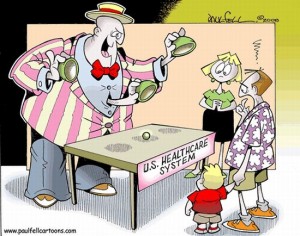 Deane Waldman, MD – U.S. healthcare has become a never-ending nightmare. Our politicians blame each other for unaffordable costs and excessive spending without ever admitting that Washington itself is the culprit.
Deane Waldman, MD – U.S. healthcare has become a never-ending nightmare. Our politicians blame each other for unaffordable costs and excessive spending without ever admitting that Washington itself is the culprit.
Health care as two words is the patient-doctor interaction. It encompasses the prevention, diagnosis, and treatment of illness or injury. Health care is inherently and necessarily complex, which is why patients need doctors.
Healthcare as one word is the system. It too is incomprehensibly complex, but its complexity is intentional, artificial, unnecessary, and a massive waste of money. If the patient (buyer) and doctor (seller) were connected directly without a third-party (payer) in between, healthcare complexity would virtually disappear.
Healthcare systems exist to organize, finance, and oversee medical care for people. In effect, healthcare exists to facilitate health… care. As Americans have learned from bitter experience, our system doesn’t work: we pay too much, we get too little, and someone else makes our medical as well as financial decisions.
Healthcare system complexity is gratuitous. A good example is the tenth edition of the International Classification of Disease (ICD-10), which is a list of codes used in the payment process. After a provider cares for a patient, the Billing and Coding Department reviews the doctor’s records and converts care activities into a series of codes that are sent to the third-party payer. This starts a long, arduous, and frankly Byzantine process.
ICD-10 contains more than 68,000 letter-number combinations used to encode approximately 1400 medical ailments, injuries and treatments. Sample codes include W55.21 (bitten by a cow), W61.33 (pecked by a chicken), V00.01 (pedestrian on foot injured in collision with a roller blader), and Y92.146 (injured at a swimming pool within a prison).
The complexity in healthcare promotes what we don’t want. Rather than incentivizing the outcome we do want — good health and long life — U.S. healthcare rewards greed: for profit by insurance companies, and for power among federal politicians and bureaucrats.
Insurance companies acquire profit by using the “three D” strategy: delay, defer, or deny patient care. As authorization, review, and payment becomes more complex, insurers pay out less and retain more revenue. The cost of this complex insurance process is passed on to the rate-payer.
The federal government gains power by increasing complexity. As the administrative and regulatory apparatus becomes ever more complex, additional bureaucrats are needed to implement, oversee and help people “navigate” the system. The famous organizational chart of the ACA prepared by Rep. Kevin Brady of Texas graphically confirms that ACA is a maze. The law was so complex that it created a whole new class of bureaucrats: navigators. If the ACA law had been planned elegantly (engineering term for simple and easy-to-use), there would be no need for navigators with their attendant costs.
Between 1970 and 2010, the number of U.S. physicians increased 150 percent. During the same time period, the number of healthcare bureaucrats increased more than 3000 percent. The state of Texas has 50,000 physicians. The Texas Health and Human Services Commission, that oversees doctors, employs 62,000 bureaucrats. Their primary job is to comply with ever-changing federal rules, regulations, and mandates.
As Washington politicians create more bureaucrats, they increase the number of voters beholden to government. Bureaucrats justify and defend the complex system in order to protect their high-paying jobs. Government bureaucrats are paid at least 17 percent more than bureaucrats in the private sector doing comparable jobs.
All this complexity doesn’t just cost some money — it wastes trillions. At least 40 percent of U.S. healthcare spending goes to bureaucracy in all forms, or what management experts call dollar inefficient spending. In 2018, the U.S. expended $3.65 trillion on its healthcare system. For perspective, the entire 2018 GDP of the United Kingdom was $3.0 trillion. Forty percent of $3.65 trillion calculates to 1,460,000,000,000 U.S. “healthcare” dollars that the federal bureaucracy paid itself and thus, took away from Americans’ health care.
Radical simplification is the solution to excessive complexity. Remove Washington from healthcare and restore the direct connection between patient and doctor.
Imagine healthcare without federal complexity and particularly without third-party decision makers. The patient shops for and chooses a doctor. The doctor provides service and gives a bill to the patient. No more preauthorization, coding, review process, denial, adjudication, or reimbursement schedules. No bureaucrat denying you the care you need. No confusion about what patient is paying for. No delay in payment. No Medicare or Medicaid fraud, which occurs exclusively through the billing and coding process.
And, gone is the cost of complexity. We suddenly release more than a trillion dollars to spend on patient care or keep in our pockets.
SF Source The American Thinker Sep 2019
